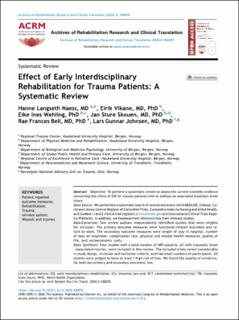| dc.description.abstract | Objective
To perform a systematic review to assess the current scientific evidence concerning the effect of EIR for trauma patients with or without an associated traumatic brain injury.
Data Source
We performed a systematic search of several electronic (Ovid MEDLINE, Embase, Cochrane Library Central Register of Controlled Trials, Cumulative Index to Nursing and Allied Health, and SveMed+) and 2 clinical trial registers (clinicaltrials.gov and International Clinical Trials Registry Platform). In addition, we handsearched reference lists from relevant studies.
Data Extraction
Two review authors independently identified studies that were eligible for inclusion. The primary outcome measures were functional-related outcomes and return to work. The secondary outcome measures were length of stay in hospital, number of days on respirator, complication rate, physical and mental health measures, quality of life, and socioeconomic costs.
Data Synthesis
Four studies with a total number of 409 subjects, all with traumatic brain–associated injuries, were included in this review. The included trials varied considerably in study design, inclusion and exclusion criteria, and had small numbers of participants. All studies were judged to have at least 1 high risk of bias. We found the quality of evidence, for both our primary and secondary outcomes, low.
Conclusions
No studies that matched our inclusion criteria for EIR for trauma patients without traumatic brain injuries could be found. For traumatic brain injuries, there are a limited number of studies demonstrating that EIR has a positive effect on functional outcomes and socioeconomic costs. This review highlights the need for further research in trauma care regarding early phase interdisciplinary rehabilitation. | en_US |

